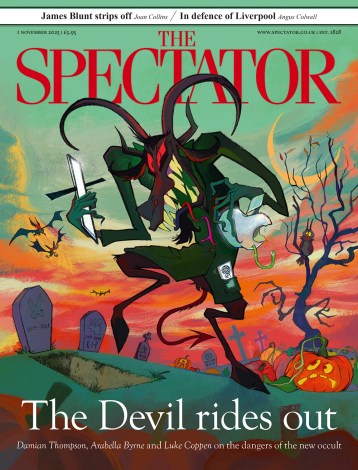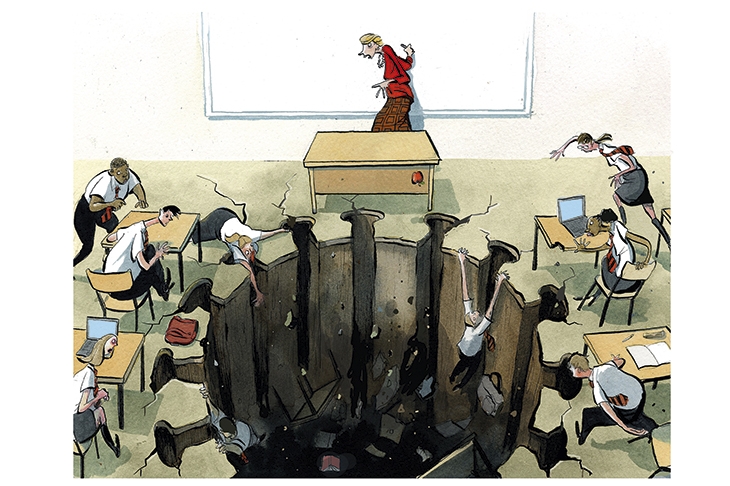Teaching unions have spent much of the past year campaigning with the social media hashtag #CloseTheSchools. It’s a reminder of the imbalance in debate over education. Unions represent the adults, MPs represent their constituents, but who in Westminster speaks for children?
In 2005 the Blair government sought to answer this question by creating a Children’s Commissioner, who would promote and protect the rights of children in decisions affecting their lives. Anne Longfield, the third to hold the job, is in the final few weeks of her six-year stint. She is spending those weeks campaigning for schools to re-open as soon as possible after the February half-term.
She believes she has more reasons to be optimistic now than she did last year when she was pushing for classroom tuition to resume in June. Back then, she says, parents and unions were reluctant. ‘Everyone was completely terrified of what was going to happen.’ That has changed. ‘Parents definitely want their kids back [at school] now,’ she says. This time, too, ‘it’s the councils and unions who are saying to me that it can be done. That feels really different’. Even Public Health England has said there is now a ‘strong case’ for the safe return of primary schools after half-term if cases continue to fall.
The political mood is less promising. Boris Johnson has this week ruled out the return to in-person education next month that he had previously hinted at. Instead, the new hope in government is for schools to begin reopening from 8 March. Should that date slide once again, don’t expect much criticism from Labour or the Liberal Democrats. It seems that no party in SW1 is advocating for the basic right of all children to go to school.

Longfield says it took a while to adjust to the fact that it would fall to her to make this fundamental case. ‘The point when I drew breath was around May/June last year,’ she says. ‘Suddenly the notion that schools would always be open and kids would always go to them seemed to evaporate. You were back to the basics of saying: kids should go to school, it’s a good thing.’ While there are plenty of politicians who insist they agree with the sentiment, it is actions that matter. ‘We can make it happen — but it’s not going to happen of its own accord,’ she says.
Her own education was at a Yorkshire grammar, followed by a history degree in Newcastle and then a career in children’s charities. She ran her own outfit, Charity 4Children, and expanded it from a staff of six people to nearly 1,500, running 100 children’s centres. In the early Blair years she worked with Harriet Harman to set up Sure Start centres and did a brief stint in government as a policy adviser.
When we meet over Skype she is halfway through writing a letter to No. 10. It includes her ‘roadmap’ for returning as many children as possible to school as soon as possible — using such measures as the staggered return of pupils and reduced class sizes — and a request for a new slide to be added to the daily press conferences charting the government’s efforts to reopen schools. This would show commitment, she says, but it would also ‘share with parents and kids what’s coming next’. Next, a plan is needed to redress the damage that has already been done by the school closures.
‘Suddenly the notion that schools would always be open and kids would always go to them seemed to evaporate’
On children’s mental health, Longfield says the evidence has been forthcoming. ‘The NHS prevalence survey last summer showed that now one in six kids have a probable mental health condition,’ she says. ‘That’s not feeling a bit off. That’s a probable mental health condition. It was one in nine three years ago. Now, it’s one in six.’
The education deficit will take longer to quantify. ‘When kids went back [after the summer holidays], teachers said they thought on average children were three months behind — but far more if they were dis-advantaged,’ she explains. ‘That hasn’t yet come through so there does need to be a mechanism that actually measures what that loss has been.’ So far, ministers have announced a catch-up programme that is due to last over a year. Longfield says that this is not enough. ‘Yes, there’s a catch-up programme, yes there’s some mental health support coming. But it’s not on the scale of the emergency that we’re talking about,’ she says.
At first, she thought two years of support would be needed. Now she thinks more. ‘As this goes on, we are talking about a cohort of children that probably, for the next three to five years, will need that kind of consideration of the loss they’ve had,’ she says. ‘Both in learning but also in that wider socialisation and confidence in their lives.’
The problems are right across the age spectrum, from two-year-olds who ‘actually have never been in places where there are other kids and they’re scared stiff of speaking to other children and are very withdrawn’ to 16-year-olds not in education or training who have spent ‘those two years in bed, in front of a games console or whatever, how do you start to go forward from that?’
And what about the children already falling through the cracks? Through the data she can gather in her role (Longfield says the Children’s Commissioner has a ‘superpower to demand any data’ from any public body) she has become aware of the true extent of ‘those hidden harms’ — from mental illness to domestic violence to truancy — which during the pandemic have ‘really exploded’. There are children who need school, and teachers, for more than just learning.
School also helps detect children who need referral to social care. In its absence, referrals have plummeted. At the beginning of the pandemic, when very few vulnerable children were going to school, the number of referrals dropped by around 50 per cent. ‘Everyone thought that when kids went back into school, there would be an explosion of referrals,’ she says. ‘I think what every-one underestimated was how long it takes a child to get the confidence to be able to share something like that. They were only starting to do so as term went on.’ Then the third lockdown happened.
‘There are still an awful lot of children who are invisible. Certainly, with domestic violence, we think it’s about 800,000 children who in some way are affected.’ Figures from her office suggest there are about 40,000 children who should have been referred for help from social services, but have not been because of school closure. ‘The immediate aftermath of the pandemic is going to be dominating the work of my office,’ she says. (Her successor starts in March.) ‘And it will be dominating children’s lives and families’ lives as they try to recover from that.’
She thinks it can be done. ‘The thing that irritates and frustrates me most is that with political will, you can move mountains. Look at what we’ve done so far — vaccination, furlough, Nightingale centres and the like,’ she says. And this is what she thinks should happen next: a nationwide mobilisation to acknowledge and repair the damage to children. ‘My argument has always been that kids haven’t had their Nightingale moment yet,’ she says. ‘There’s still time.’







Comments